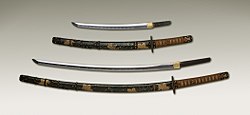Wakizashi
The wakizashi is a traditional Japanese sword. It is shorter than the katana, which was well known in the beginning of the 17th century as a kodachi sword. The two swords were always carried together: the wakizashi finished off the work of the katana sword. Such a sword could be from 30cm to 60cm (12 to 24 inches) long. A small version was called a "ko-wakizashi", a longer one was called an "o-wakizashi". The wakizashi has a handle made of stingray skin and the blade is made from the finest metal and stone.
Overview
A wakizashi had a slightly curved blade with a square-shaped hilt (handle). The hilt and the scabbard (the case in which the sword is kept) of a wakizashi was richly decorated with traditional motifs. A wakizashi was more decorated than a katana because it was not used as much as a katana, but still carried everywhere. Another distinctive feature is the scabbard (called a "saya"). The sayas were made to be like the katana but they could have extra pockets for smaller knives, a hair arranger, etc.
The katana and the wakizashi together are called a daishō, which is translated as "large and small". The first part of the word (dai) means "big" and stands for the katana sword; the second (sho) stands for wakizashi. Wakizashi was more decorated than a katana and it was thinner, this is why it was designed to cut through softer targets. So it was a sword to make dangerous cuts in weak points of the human body. The use of a daishō on the battlefield gave its user a big advantage. With the two swords the samurai could keep the enemies within a radius of action ranging from 2 to 7 feet (1 to 3 1/2 meters). Miyamoto Musashi, a famous Japanese samurai, was especially skilful at using the daishō.
Customs and traditions
A wakizashi sword was an irreplaceable weapon for a samurai. The tradition says that when entering a house or any other building, the samurai has to leave his katana with a servant, but the wakizashi could be worn at all times and places. This is why the wakizashi is often called the samurai's side arm. The wakizashi followed his master even when he went to sleep, because it was always near the bed.
The wakizashi was carried along the thigh and was usually used with one hand; the other hand was used for the katana. The wakizashi proved to be very effective when the katana's length and weight made it hard to use. The wakizashi needs less force to use and it is more maneuverable.
The wakizashi was also the sword used by merchants and artisans (types of traders) who were forbidden from wearing a katana. This fact explains a greater number wakizashi swords were found than katanas. There are even more wakizashi swords than katana swords, although the katana swords had greater meaning for Japanese society.
Seppuku
The wakizashi sword was much used in the ritual of seppuku (suicide because of lost honor). In this ritual it was used along with the shortest Japanese sword - Tanto. The wakizashi was thrust into the torso (body), cutting open horizontally. This kind of death was considered honorable for a samurai. When a female samurai committed seppuku she would only cut her own throat.
Wakizashi Media
Although the number of forged swords decreased in the Meiji period, many artistically excellent mountings were made. A wakizashi forged by Soshu Akihiro. Nanboku-chō period (top). Wakizashi mounting, Early Meiji period (bottom).
Source
- Technique of Katana Sword Drawing - IAI-DO Archived 2007-08-31 at the Wayback Machine - Facts about katana and wakizashi, how to take them out of the scabbard and notable terminology.


